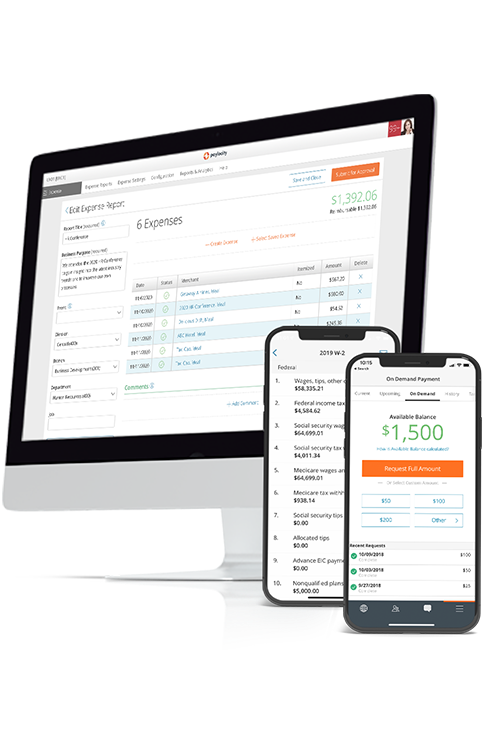resources
How Does Payroll Processing Work?
February 23, 2024

"If nothing else, ensure your workers get paid." - Some payroll guru… probably.
Efficient and reliable payroll processing can be one of the most important factors of an organization's overall success. It not only shows employees that their time and work are valued but also influences their trust and engagement within the workplace more than any piece of swag they'll receive.
Moreover, paying employees accurately and on time can substantially help meet compliance requirements and even save the organization time and money.
So, if payroll processing is such a crucial component, how do you guarantee your organization not only gets it right the first time but every time?
In this guide, we'll answer questions like “What is the payroll process?” and “How does payroll work?”. We’ll also explore what documents are involved and then show why a modern solution like Paylocity is just what the payroll guru ordered.
Key Takeaways
- Payroll processing is the method employers use to compensate your employees for the work they perform.
- It includes tracking hours worked and attendance, calculating wages, withholding taxes and benefits, and delivering payments.
- Automated payroll systems save time, reduce errors, and are easier to customize.
What is Payroll Processing?
Payroll processing is the method you use to compensate your employees for the work they perform. It includes calculating wages, withholding taxes and benefit premiums, and delivering payment—often through direct deposit.
Depending on the size of your business, this process can be quite time consuming, which is why organizations, both large and small, invest in processing software to automate the steps covered below.
Why is Payroll Processing Important?
Payroll processing is important for a variety of reasons一not least is that late or inaccurate payments are serious morale-killers.
To keep your employees happy, you need a solid payroll system to pay people what they've earned when they expect it. This isn’t only about being a good employer. Paid workers tend to be more productive!
In addition, if you don't pay your employees reliably, they may start to question your company’s financial stability. This could lead them to become less engaged and less motivated to perform.
Finally, a good payroll system ensures you fulfill your employer tax obligations at the federal, state, and even local level. It’s critical to stay compliant with employment laws. You'll not only avoid costly fines, but also maintain your reputation with employees.
What Are the Types of Payroll Processing?
Common payroll processes include paying by hour, salary, and commission. Employers must correctly classify employees under the Fair Labor Standards Act to determine their eligibility for overtime pay, breaks, and other employment benefits.
| Wage Type | Paid by | Entitled to overtime |
|---|---|---|
| Hourly | Hours worked | Yes (non-exempt) |
| Salary | Monthly or annual salary | Sometimes (non-exempt and exempt) |
| Commission | Straight commission or commission with base salary | Sometimes (non-exempt and exempt) |
Additionally, you’ll need to decide how to provide payment to employees (paper checks, direct deposit, or both) and the logistics of how you'll process payroll. Again, manual payroll processing can be tedious and error-prone, so most organizations use payroll processing software like Paylocity.
What is Needed to Process Payroll?
The payroll process involves several steps. First, you need to apply for a federal employer identification number (FEIN), a state tax identification number, and possibly a local identification number for your business. These allow you to file and pay payroll taxes.
Next, you need to collect and retain certain information and documents from your employees to have on file for their paychecks. This includes their:
- Social Security Number
- State and federal W-4 forms (state and federal income taxes)
- Form I-9 (employment eligibility verification)
- State withholding form (state income taxes)
- Note, not all states require a withholding form. Check with your individual state's Department of Revenue for more information.
- Bank account information
- Benefits elections (insurance, retirement, etc.)
How Long Does Payroll Processing Take?
How long it takes to process payroll depends on whether you’re using manual or automated processes and how many employees you have. Businesses with payroll processing solutions typically finish internal processes in one to two days.
After payroll is submitted to the bank, it takes two to three days for wages to be deposited into employee bank accounts. So, employees receive their paychecks, on average, within five days of the pay period end date.
What Is a Typical Payroll Cycle?
When you hire employees, you’ll need to determine how often to pay them. The most common payroll cycles are weekly, bi-weekly, semi-monthly, and monthly:
| Payroll Cycle | Number of paychecks a year | Common for |
|---|---|---|
| Weekly | 52 | Hourly employees |
| Bi-weekly | 26 | Hourly and salaried employees |
| Semi-monthly | 24 | Salaried employees |
| Monthly | 12 | Salaried employees |
Again, review wage and hour laws in your state to ensure your payroll cycle meets compliance requirements.
Can Employers Delay Payroll Processing?
Employers must pay their employees according to their payroll schedule. Federal law requires employers to pay employees “promptly” for hours worked, while state law is more specific in many cases.
Subsequently, delaying payroll can lead to costly fines and penalties. Be sure to determine which payroll frequencies (weekly, bi-weekly, semi-monthly, monthly) are acceptable in all the states where you workers are located.
How Does Payroll Processing Work?
Payroll processing is a multi-step process for any company, which requires all the same components whether an organization is a small business or a large enterprise.
After you've obtained your federal and state ID numbers, established a payroll cycle, determined wage classifications and requirements, and collected all relevant employee information, you’re ready to run your first payroll:
Track Time & Attendance
Before you can calculate each employee's pay, you need to know how much they worked during that pay cycle. Most organizations track this information with time and attendance software, especially if they have complicated pay practices, such as shift differentials, weekend pay, overtime, critical shift pay, per-piece pay, etc.
Even if your pay structure has fewer categories, you can still benefit from a robust time tracking solution that makes it easy for employees to log and review their hours worked.
Review and Approve Time
A compliant payroll business process will include supervisor review and approval of timecards before the payroll is actually processed. Each employee’s timecard should be reviewed carefully, and corrections should be made where needed — before the checks are cut. Moreover, the supervisor's approval should also be documented and retained in case of a future audit.
Calculate Wages and Deductions
When an employee's timecard is approved, calculate their gross earnings.
| Wage Type | Gross Pay Calculation |
|---|---|
| Hourly |
[Hours Worked] x [Rate of Pay] = [Gross Pay] 40 x $18 = $720 |
| Salaried |
[Annual Salary] ÷ [Number of Paychecks a year] = [Gross Pay] $45,000 ÷ 26 = $1,730 |
Next, calculate each employee's taxes, benefits premiums, garnishments, and other authorized deductions and withholdings based on the documents and information you previously gathered from them (W-4, retirement elections, etc.). Deduct and withhold these amounts from the employee's gross pay to find their net pay.
Submit or Disburse Payroll
For any employees with direct deposit, you’ll next submit the finished payroll to your organization's banking agent for disbursement. For any employees who receive paper checks, you’ll instead order printed checks with pay stubs and manually distribute them to each employee.
Most employers use a combination of these two methods, though some payroll providers offer additional options, such as on-demand pay or paycards, for when employees need quicker access to their earned wages.
Pay Taxes
After processing payroll, file and remit payments for all of your state and federal payroll taxes as well as any state or federal income taxes you withheld on behalf of each employee. Timely deposits can help you avoid penalties at quarter-end, so remember to track key deadlines.
Normally, the Internal Revenue Service (IRS) requires payroll tax deposits in the form of an Electronic Fund Transfer (EFT), on the Department of Treasury's Electronic Federal Tax Payment System (EFTPS).
Read More: Read More: Payroll Taxes & Form 941: How to File and Important Due Dates
Post to General Ledger
Be sure to log payroll expenses in your general ledger at the end of the payroll process after all payments to employees have been made.
This ensures that your financial records accurately reflect all payroll expenses and liabilities incurred during the payroll period. The posting process involves summarizing the payroll transactions (such as gross wages, taxes withheld, employer tax contributions, and other deductions) and recording them in the appropriate accounts within the general ledger.
If you use payroll software, you’ll likely be able to export a file to import the necessary entries into your accounting platform. More advanced payroll solutions will offer accounting integrations with easy self-serve mapping configuration that automatically post entries to your general ledger.
Retain Records
Businesses are required to retain payroll and tax records according to state and federal records retention laws. Per the Department of Labor, the Fair Labor Standards Act (FLSA) requires employers to maintain these records for at least three years. It’s also a good idea to retain these records to resolve any future legal or regulatory issues.
Three Advantages of an Automated Payroll Processing System
With so much riding on getting payroll right, investing in the right HR payroll processing system is an important business decision. Digital payroll processing systems offer several key advantages over manual payroll processing:
1. Saved time
The biggest advantage of a payroll system is the amount of time you save. Payroll software automates a variety of manual processes, letting you focus on more strategic tasks that grow your business.
Payroll processing systems calculate wages automatically, so you don’t lose time doing it manually. Plus, they send automated reminders for managers to approve employees’ time, so no more chasing down timesheets and signatures.
Additionally, payroll software stores your information securely in one place, which means you don’t waste time searching for it. It’s right there when you need it.
2. Reduced errors
Automation also reduces the chances of costly payroll errors.
If you make an error that underpays your employees, it damages their trust and could lead to legal action.
If you overpay employees, you’ll lose valuable capital and have to spend time recouping it.
And, if you make a tax error, it could result in significant penalties — and more lost time.
A payroll system will accurately track your employees’ time and calculate wages automatically, so you’ll always pay them exactly what they’ve earned. It will also help prevent tax errors and keep you compliant with current employment regulations.
3. Easier customization
Simple customization is one of the must-have payroll software features that’s easy to overlook, but of crucial value.
You want a payroll system that’s simple to customize so you and your employees can quickly make changes without having to contact admin through an employee self-service portal. In fact, a cloud-based system like Paylocity lets you update information from anywhere as long as you have the right clearance.
You can customize payroll processing software according to employee count, payment structure, payment schedule, tax deductions, and more, letting you provide the best service to your employees.
Why Paylocity for Payroll Processing?
Taking all of these details and nuances into account, it's no surprise organizations of all sizes need help making sure all their employees receive the correct pay at the correct time. It's true, you can do all of the above steps manually, but working with Paylocity as your payroll processing provider includes extensive peace-of-mind perks like:
- A menu of features to choose from in addition to payroll, including time and attendance, benefits administration, and more.
- Pre-built interfaces with more than 300 third-party systems so you can receive and send data to the systems you’re already using.
- Automated payroll tax filing and payment, including federal and state taxes, social security taxes, and Medicare taxes.
- Exceptional technical support and customer service for all business sizes.
- Employee self-service for quick access to pay stubs, W-4s, W-2s, and more.
- A robust document library to store all employee forms and payroll records.
To explore Paylocity as a potential payroll service for your organization, request a payroll demo today.




